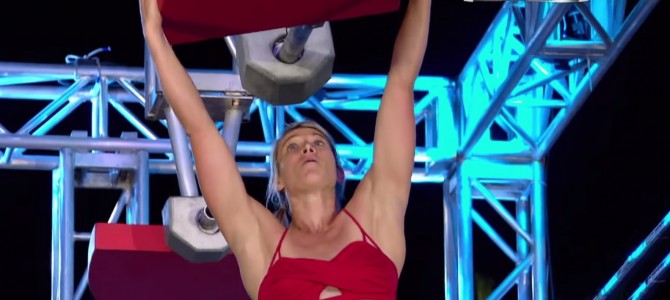
There are plenty of things to feel rotten about nowadays—yesterday’s on-air shooting of two TV reporters, ISIS expanding its caliphate in the Middle East and beheading Christians and Muslims along the way, a stagnant economy, widespread government corruption, and heightened racial tensions.
As world affairs spiral downward, the constants of our Western lives (besides death and taxes) remain sports and entertainment. When we watch the Super Bowl or a captivating TV drama, we forget our troubles, which is why movies were as popular as ever during the Great Depression. Successfully captivating millions of Americans with thousands of entertainment options at the press of a button, NBC and Esquire Network’s show “American Ninja Warrior” will be wrapping up its seventh season in September.
As a natural pessimist self-taught in optimism, among all my options for entertainment, from fantasy-disaster scenarios like FX’s “The Strain” to NBC’s “Community” and the National Football League, I’ve found “American Ninja Warrior” to be the best diversion from reality, and one that actually clears away some of those low clouds of pessimism that overcast my thoughts on current events. What can I say, who doesn’t smile at the prospect of a weatherman or stockbroker tackling an obstacle course with spinning logs, salmon ladders, and flying bars, all suspended over water?
Ordinary People Doing Extraordinary Things
ANW has produced surprise after surprise as its competitors try themselves on the world’s most difficult obstacle course with a $1 million prize for the finisher, delivering an intensity and excitement only found in athletic competitions, but a universally unified fan base rarely found in sports.
Such awe-inspiring events include meteorologist Joe Moravsky’s superb rookie performance in 2013, where he impressed everyone by making it all the way to stage three of the national finals course (called Mt. Midoriyama); Kacy Catanzaro’s historic run in 2014 as the first woman to complete a qualifying region finals course; and rock climber Brian Arnold’s nail-biting journey the same year to make it further on the grueling Mt. Midoriyama course than any other American in a suspenseful USA versus The World Ninja Warrior event.
For simply exciting television and many more reasons, anyone afflicted with the widespread chronic cynicism about American politics and the country’s economic and moral outlook should watch “American Ninja Warrior.” Trust me, you’ll feel better.
Exciting Television Without Spectator Drama
ANW is exciting and unpredictable, yet family friendly—a rare combination in television these days. Yet what really makes ANW unique from other sports programs is that it unites viewers behind every contestant instead of dividing spectators along college or city allegiances (Cougars vs. Huskies, Seahawks vs. 49ers, etc.).
In other words, you get to root for everyone (but whose hearts don’t beat with just a little more pride when watching the special military qualifying round, or an amputee competing on a prosthetic leg?). You don’t need to have an investment in a particular team or player to thoroughly enjoy it, just a general sense of amazement and desire to see competitors’ succeed.
Moreover, you don’t need to know a lot of rules to understand what’s going on or to be impressed by the competitors’ efforts. Not everyone fully grasps the skill needed to keep both feet inside the white line when catching a football, or to sneak a soccer ball past a professional goalie, but pretty much everyone understands that moving a metal bar up five different rungs using only your upper body strength and momentum is really, really hard.
The only rules for ANW are 1) Don’t touch the water and 2) Don’t cheat the obstacles (grabbing the structure above the obstacle, for instance). You don’t need a lot of knowledge to be a good fan of the sport.
No Battle of the Sexes
Another refreshing aspect of “Ninja Warrior” is its lack of gender, age (save for being at least 21), or weight classifications, since competitors are not directly matching up against competitors who may be stronger, faster, or more agile, measuring punch to punch, muscle to muscle, size to size. In ANW, competitors match up against the series of obstacles, but each athlete is really battling his or her own weight, reach, grip strength, and other individual factors. For instance, Catanzaro may be much lighter than the 170-pound male competitor next to her, and that could give her an advantage on hanging obstacles; however, Kacy is just five feet tall, so her arm span proves a greater challenge in reaching from bar to bar or leaping up to grab a rope than for someone a foot taller.
Personally, I cheer with a little more gusto when females compete, if only because there aren’t many female athletes who are both capable and willing to compete on obstacles biased toward people with immense upper-body strength, a category filled almost exclusively by men. But it isn’t a battle of the sexes, and females aren’t being cheated. The course is what it is—you either beat the obstacle or you don’t.
Everyone wants that $1 million prize, but at the end of it all, it’s about how far you can push yourself, making gender irrelevant and leaving ANW untainted thus far by such controversies like whether transgender women should be allowed to fight in women’s mixed martial arts.
Indeed, amid the growing din of political sports commentary filling the ears of dedicated ESPN viewers and casual sports fans alike, ANW has remained largely unaffected by the more divisive and inflammatory political elements currently plaguing national sports leagues. It remains, at least for the meantime, a wholesome competition free from most of the political and cultural drama weighing on our spirits.
It’s Not a Popularity Contest
Much like the popularity talent shows, people from every walk of life, from stunt doubles to gym teachers to butchers, compete and find comradery with other contestants from vastly different backgrounds; this adds a layer of relatability and even warm fuzzy feelings generated from the unity among “ninjas” despite such diversity.
But ANW is superior television to “American Idol” and other talent-based shows in that it’s not a popularity contest where judges or viewers subjectively pick winners, but a true competition based on a set of fixed challenges and rules. There is no sudden outrage that your favorite vocalist or dancer was voted out, no caustic disagreements among judges and viewers on who did well and who didn’t. Neither is it like the big professional sports leagues in that you don’t retire, sulking, to your room after a game feeling cheated by a referee’s bad call, or angry at an offensive coordinator’s decision to pass the ball on the one-yard line instead of run it, or ticked off at the suspension of a key player for a minor offense.
No other subjective factors enter the mix beyond the decision of who gets to compete on the show. It’s just a man or woman against the obstacle course. Talent-show narratives of no name to world fame can be inspiring, something good and interesting, but nothing more than a public spectacle. ANW goes beyond rags to riches (perhaps because so far it has produced no prizes for its contestants), inspiring us to push our outermost limits to reach our goals through demonstrating strength, agility, and sheer determination.
There’s nothing inherently wrong with a popularity contest, or with national sports leagues, but they ring of a similar disharmony and contention generated in both national and workplace politics, especially running up to election season. These days, we need a TV show that blocks out the negative drama of current affairs without carrying us all the way in the other direction, into fiction, where again we either meet our own world dressed differently, or an emptyheaded romp through a glittering fantasy that leaves us unsatisfied if not preoccupied.
Showing Perseverance Through Failure
But unlike talent shows such as “American Idol” or “America’s Got Talent,” “Ninja Warrior” is not a single shot at fame and fortune, but a continual press to expand one’s capabilities and learn from one’s experiences, manifesting first in blistered hands, bruised knees, and aching arms, then in the elating arrival at new personal milestones. In ANW, viewers can see the rollercoaster-like journey of many “ninjas” across several seasons, showing us the dogged perseverance that leads to success in year after year of struggle and triumph by individual athletes.
For example, one of ANW’s oldest competitors, Sam Sann, 48, has competed four consecutive years, progressing from an unremarkable failure on the qualifying course in season four to a smooth finish of the very difficult Houston finals course in season seven, where only two competitors were able to complete the entire series of obstacles. As an older competitor, Sann said, “I have to train differently. I have to train harder, train smarter than the young guys.” In his own ANW gym, he demonstrates that practice does pay off.
In similar fashion, Flip Rodriguez, a veteran competitor identifiable primarily by his black and white mask, shockingly failed early in the qualifying round last season, but came back in season seven with an unshakeable will to overcome his careless mistake. Abandoning his famous mask, he met his challenge with barefaced determination. With seriousness and grace, he overcame each obstacle like a professional—a complete turnaround from his hurried performance approach in season six.
The competition is certainly set apart from other televised sports or athletic competitions in that, practically speaking, it isn’t about an ultimate, definitive victory, just as life isn’t about ultimate victory, but overcoming a succession of challenges in pursuit of one’s goals. One might say that “American Ninja Warrior” is more about mastering the art of graceful failure and will-powered recovery than about winning, since no one has ever “won” “American Ninja Warrior” in all its previous six seasons.
With no mandatory helmets or masks, and no team franchise buffering between the viewer and an individual mental and physical struggle, “Ninja Warrior” puts the real expressions of failure and success, pain and elation, on maxims like “get back on the horse” or “try, try again,” making the competitors’ stories and personal goals that much more relatable, inspiring, and motivating in a way that popular proverbs can’t.
“American Ninja Warrior” may be a copycat of the popular Japanese competition, “Sasuke,” but it is somehow wholly American, exemplifying the best of the American spirit and strength—that long-held effervescent optimism Alexis de Tocqueville admired, that unrelenting willpower, dedication and work ethic that propels us toward success, in business, sports, and the rest of our lives. And in this dark moment of American history, when our outlook is grim, perhaps its most important message is: rise to the challenge, give it everything you’ve got, and don’t give up.









